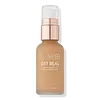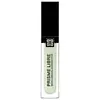What's inside
What's inside
 Key Ingredients
Key Ingredients

 Benefits
Benefits

 Concerns
Concerns

 Ingredients Side-by-side
Ingredients Side-by-side

Water
Skin ConditioningPropanediol
SolventNeopentyl Glycol Dicaprate
EmollientCaprylic/Capric Triglyceride
MaskingTriethylhexanoin
MaskingC9-12 Alkane
SolventGlycerin
HumectantPolymethylsilsesquioxane
Glyceryl Oleate
EmollientC13-15 Alkane
SolventPolyglyceryl-3 Polyricinoleate
EmulsifyingLactobacillus Ferment
Skin ConditioningSilica
AbrasiveSodium Chloride
MaskingSorbitan Isostearate
EmulsifyingLavandula Angustifolia Flower Water
Skin ConditioningQuaternium-90 Bentonite
Magnesium Aluminum Silicate
AbsorbentGlyceryl Caprylate
EmollientCoco-Caprylate/Caprate
EmollientTriethyl Citrate
MaskingLauroyl Lysine
Skin ConditioningOlea Europaea Oil Unsaponifiables
Skin ConditioningAcacia Senegal Gum
MaskingXanthan Gum
EmulsifyingBetaine
HumectantDisodium EDTA
Capric Acid
CleansingPotassium Sorbate
PreservativeTremella Fuciformis Sporocarp Extract
AntioxidantWithania Somnifera Root Extract
Skin ConditioningLavandula Hybrida Oil
EmollientTocopherol
AntioxidantCitric Acid
BufferingSodium Benzoate
MaskingPhenoxyethanol
PreservativeWater, Propanediol, Neopentyl Glycol Dicaprate, Caprylic/Capric Triglyceride, Triethylhexanoin, C9-12 Alkane, Glycerin, Polymethylsilsesquioxane, Glyceryl Oleate, C13-15 Alkane, Polyglyceryl-3 Polyricinoleate, Lactobacillus Ferment, Silica, Sodium Chloride, Sorbitan Isostearate, Lavandula Angustifolia Flower Water, Quaternium-90 Bentonite, Magnesium Aluminum Silicate, Glyceryl Caprylate, Coco-Caprylate/Caprate, Triethyl Citrate, Lauroyl Lysine, Olea Europaea Oil Unsaponifiables, Acacia Senegal Gum, Xanthan Gum, Betaine, Disodium EDTA, Capric Acid, Potassium Sorbate, Tremella Fuciformis Sporocarp Extract, Withania Somnifera Root Extract, Lavandula Hybrida Oil, Tocopherol, Citric Acid, Sodium Benzoate, Phenoxyethanol
Water
Skin ConditioningC9-12 Alkane
SolventCaprylic/Capric Triglyceride
MaskingGlycerin
HumectantCI 77891
Cosmetic ColorantPropanediol
SolventCI 77163
Cosmetic ColorantCoco-Caprylate/Caprate
EmollientPentylene Glycol
Skin ConditioningStearalkonium Hectorite
Gel FormingTrimethylsiloxysilicate
EmollientPullulan
Sorbitan Sesquiisostearate
EmulsifyingSilica
AbrasivePolyglyceryl-3 Polyricinoleate
EmulsifyingPolyglyceryl-3 Diisostearate
EmulsifyingEthylene Brassylate
MaskingHydroxyacetophenone
AntioxidantSodium Chloride
MaskingCI 77288
Cosmetic ColorantSodium Benzoate
MaskingSynthetic Fluorphlogopite
Sodium Myristoyl Glutamate
CleansingTropaeolum Majus Flower/Leaf/Stem Extract
Skin ConditioningPolyhydroxystearic Acid
EmulsifyingCI 77492
Cosmetic ColorantPropylene Carbonate
SolventTocopherol
AntioxidantAluminum Hydroxide
EmollientCI 77491
Cosmetic ColorantIsostearic Acid
CleansingLecithin
EmollientTin Oxide
AbrasiveCitric Acid
BufferingWater, C9-12 Alkane, Caprylic/Capric Triglyceride, Glycerin, CI 77891, Propanediol, CI 77163, Coco-Caprylate/Caprate, Pentylene Glycol, Stearalkonium Hectorite, Trimethylsiloxysilicate, Pullulan, Sorbitan Sesquiisostearate, Silica, Polyglyceryl-3 Polyricinoleate, Polyglyceryl-3 Diisostearate, Ethylene Brassylate, Hydroxyacetophenone, Sodium Chloride, CI 77288, Sodium Benzoate, Synthetic Fluorphlogopite, Sodium Myristoyl Glutamate, Tropaeolum Majus Flower/Leaf/Stem Extract, Polyhydroxystearic Acid, CI 77492, Propylene Carbonate, Tocopherol, Aluminum Hydroxide, CI 77491, Isostearic Acid, Lecithin, Tin Oxide, Citric Acid
Ingredients Explained
These ingredients are found in both products.
Ingredients higher up in an ingredient list are typically present in a larger amount.
C9-12 Alkane is synethically created using alkanes, or paraffins. It is added to products as a solvent. This means its main purpose is to help dissolve ingredients and create even texture.
This ingredient is an emollient, solvent, and texture enhancer. It is considered a skin-softener by helping the skin prevent moisture loss.
It helps thicken a product's formula and makes it easier to spread by dissolving clumping compounds.
Caprylic Triglyceride is made by combining glycerin with coconut oil, forming a clear liquid.
While there is an assumption Caprylic Triglyceride can clog pores due to it being derived from coconut oil, there is no research supporting this.
Learn more about Caprylic/Capric TriglycerideCitric Acid is an alpha hydroxy acid (AHA) naturally found in citrus fruits like oranges, lemons, and limes.
Like other AHAs, citric acid can exfoliate skin by breaking down the bonds that hold dead skin cells together. This helps reveal smoother and brighter skin underneath.
However, this exfoliating effect only happens at high concentrations (20%) which can be hard to find in cosmetic products.
Due to this, citric acid is usually included in small amounts as a pH adjuster. This helps keep products slightly more acidic and compatible with skin's natural pH.
In skincare formulas, citric acid can:
While it can provide some skin benefits, research shows lactic acid and glycolic acid are generally more effective and less irritating exfoliants.
Most citric acid used in skincare today is made by fermenting sugars (usually from molasses). This synthetic version is identical to the natural citrus form but easier to stabilize and use in formulations.
Read more about some other popular AHA's here:
Learn more about Citric AcidCoco-Caprylate/Caprate is created from fatty coconut alcohol, caprylic acid, and capric acid.
It is a lightweight emollient. Emollients create a thin barrier on the skin to trap moisture in. This helps keep your skin hydrated and soft.
Once applied, Coco-Caprylate/Caprate is absorbed quickly and leaves a silky feel.
Coco-Caprylate/Caprate may not be fungal acne safe.
Learn more about Coco-Caprylate/CaprateGlycerin is already naturally found in your skin. It helps moisturize and protect your skin.
A study from 2016 found glycerin to be more effective as a humectant than AHAs and hyaluronic acid.
As a humectant, it helps the skin stay hydrated by pulling moisture to your skin. The low molecular weight of glycerin allows it to pull moisture into the deeper layers of your skin.
Hydrated skin improves your skin barrier; Your skin barrier helps protect against irritants and bacteria.
Glycerin has also been found to have antimicrobial and antiviral properties. Due to these properties, glycerin is often used in wound and burn treatments.
In cosmetics, glycerin is usually derived from plants such as soybean or palm. However, it can also be sourced from animals, such as tallow or animal fat.
This ingredient is organic, colorless, odorless, and non-toxic.
Glycerin is the name for this ingredient in American English. British English uses Glycerol/Glycerine.
Learn more about GlycerinThis ingredient is an emulsifier. It is created from Polyglycerin-3 and Ricinoleic Acid.
As an emulsifier, it prevents waters and oils from separating. According to a manufacturer this ingredient is fully biodegradable.
This ingredient may not be safe for Malassezia folliculitis due to its Ricinoleic Acid base. Ricinoleic Acid is a fatty acid derived from castor oil.
Learn more about Polyglyceryl-3 PolyricinoleatePropanediol is an all-star ingredient. It softens, hydrates, and smooths the skin.
It’s often used to:
Propanediol is not likely to cause sensitivity and considered safe to use. It is derived from corn or petroleum with a clear color and no scent.
Learn more about PropanediolSilica, also known as silicon dioxide, is a naturally occurring mineral. It is used as a fine, spherical, and porous powder in cosmetics.
Though it has exfoliant properties, the function of silica varies depending on the product.
The unique structure of silica enhances the spreadability and adds smoothness, making it a great texture enhancer.
It is also used as an active carrier, emulsifier, and mattifier due to its ability to absorb excess oil.
In some products, tiny microneedles called spicules are made from silica or hydrolyzed sponge. When you rub them in, they lightly polish away dead skin layers and enhance the penetration of active ingredients.
Learn more about SilicaSodium Benzoate is a preservative. It's used in both cosmetic and food products to inhibit the growth of mold and bacteria. It is typically produced synthetically.
Both the US FDA and EU Health Committee have approved the use of sodium benzoate. In the US, levels of 0.1% (of the total product) are allowed.
Sodium benzoate works as a preservative by inhibiting the growth of bacteria inside of cells. It prevents the cell from fermenting a type of sugar using an enzyme called phosphofructokinase.
It is the salt of benzoic acid. Foods containing sodium benzoate include soda, salad dressings, condiments, fruit juices, wines, and snack foods.
Studies for using ascorbic acid and sodium benzoate in cosmetics are lacking, especially in skincare routines with multiple steps.
We always recommend speaking with a professional, such as a dermatologist, if you have any concerns.
Learn more about Sodium BenzoateChances are, you eat sodium chloride every day. Sodium Chloride is also known as table salt.
This ingredient has many purposes in skincare: thickener, emulsifier, and exfoliator.
You'll most likely find this ingredient in cleansers where it is used to create a gel-like texture. As an emulsifier, it also prevents ingredients from separating.
There is much debate on whether this ingredient is comedogenic. The short answer - comedogenic ratings don't tell the whole story. Learn more about comegodenic ratings here.
The concensus about this ingredient causing acne seems to be divided. Research is needed to understand if this ingredient does cause acne.
Scrubs may use salt as the primary exfoliating ingredient.
Learn more about Sodium ChlorideTocopherol (also known as Vitamin E) is a common antioxidant used to help protect the skin from free-radicals and strengthen the skin barrier. It's also fat soluble - this means our skin is great at absorbing it.
Vitamin E also helps keep your natural skin lipids healthy. Your lipid skin barrier naturally consists of lipids, ceramides, and fatty acids. Vitamin E offers extra protection for your skin’s lipid barrier, keeping your skin healthy and nourished.
Another benefit is a bit of UV protection. Vitamin E helps reduce the damage caused by UVB rays. (It should not replace your sunscreen). Combining it with Vitamin C can decrease sunburned cells and hyperpigmentation after UV exposure.
You might have noticed Vitamin E + C often paired together. This is because it is great at stabilizing Vitamin C. Using the two together helps increase the effectiveness of both ingredients.
There are often claims that Vitamin E can reduce/prevent scarring, but these claims haven't been confirmed by scientific research.
Learn more about TocopherolWater. It's the most common cosmetic ingredient of all. You'll usually see it at the top of ingredient lists, meaning that it makes up the largest part of the product.
So why is it so popular? Water most often acts as a solvent - this means that it helps dissolve other ingredients into the formulation.
You'll also recognize water as that liquid we all need to stay alive. If you see this, drink a glass of water. Stay hydrated!
Learn more about Water